Carbon Felt Composite Electrode Plates Promote Methanogenesis through Microbial Electrolytic Cells
Abstract
1. Introduction
2. Material and Methods
2.1. Substrates and Inoculum
2.2. Constant Temperature MEC Anaerobic Digestion Experiment Station
2.3. Experimental Methods
2.4. Microbial Community Analysis
2.5. Statistical Analysis
3. Results and Discussion
3.1. Cumulative Biogas Production and Daily Biogas Production
3.2. Daily Methane Content
3.3. Chemical Oxygen Demand, Ammonia Nitrogen and pH
3.4. Microbial Community
3.4.1. Alpha Diversity Analysis
3.4.2. Analysis of Archaea Community
4. Conclusions
Author Contributions
Funding
Data Availability Statement
Acknowledgments
Conflicts of Interest
References
- Liu, X.; Bayard, R.; Benbelkacem, H.; Buffiere, P.; Gourdon, R. Evaluation of the correlations between biodegradability of lignocellulosic feedstocks in anaerobic digestion process and their biochemical characteristics. Biomass Bioenergy 2015, 81, 534–543. [Google Scholar] [CrossRef]
- Lee, W.S.; Chua, A.S.M.; Yeoh, H.K.; Ngoh, G.C. A review of the production and applications of waste-derived volatile fatty acids. Chem. Eng. J. 2014, 235, 83–99. [Google Scholar] [CrossRef]
- Aryal, N.; Tremblay, P.-L.; Lizak, D.M.; Zhang, T. Performance of different Sporomusa species for the microbial electrosynthesis of acetate from carbon dioxide. Bioresour. Technol. 2017, 233, 184–190. [Google Scholar] [CrossRef] [PubMed]
- Peces, M.; Astals, S.; Clarke, W.P.; Jensen, P.D. Semi-aerobic fermentation as a novel pre-treatment to obtain VFA and increase methane yield from primary sludge. Bioresour. Technol. 2016, 200, 631–638. [Google Scholar] [CrossRef]
- Schlager, S.; Haberbauer, M.; Fuchsbauer, A.; Hemmelmair, C.; Dumitru, L.M.; Hinterberger, G.; Neugebauer, H.; Sariciftci, N.S. Bio-Electrocatalytic Application of Microorganisms for Carbon Dioxide Reduction to Methane. Chemsuschem 2017, 10, 226–233. [Google Scholar] [CrossRef]
- Mier, A.A.; Olvera-Vargas, H.; Mejia-Lopez, M.; Longoria, A.; Verea, L.; Sebastian, P.J.; Arias, D.M. A review of recent advances in electrode materials for emerging bioelectrochemical systems: From biofilm-bearing anodes to specialized cathodes. Chemosphere 2021, 283, 131138. [Google Scholar] [CrossRef]
- Quashie, F.K.; Feng, K.; Fang, A.; Agorinya, S.; Antwi, P.; Kabutey, F.T.; Xing, D. Efficiency and key functional genera responsible for simultaneous methanation and bioelectricity generation within a continuous stirred microbial electrolysis cell (CSMEC) treating food waste. Sci. Total Environ. 2021, 757, 143746. [Google Scholar] [CrossRef] [PubMed]
- Wang, W.; Chang, J.-S.; Lee, D.-J. Integrating anaerobic digestion with bioelectrochemical system for performance enhancement: A mini review. Bioresour. Technol. 2022, 345, 126519. [Google Scholar] [CrossRef]
- Zakaria, B.S.; Dhar, B.R. Progress towards catalyzing electro-methanogenesis in anaerobic digestion process: Fundamentals, process optimization, design and scale-up considerations. Bioresour. Technol. 2019, 289, 121738. [Google Scholar] [CrossRef] [PubMed]
- Huong Thi Thu, N.; Noori, M.T.; Min, B. Accelerating anaerobic digestion process with novel single chamber microbial electrochemical systems with baffle. Bioresour. Technol. 2022, 359, 127474. [Google Scholar]
- Ding, P.; Wu, P.; Jie, Z.; Cui, M.-H.; Liu, H. Damage of anodic biofilms by high salinity deteriorates PAHs degradation in single-chamber microbial electrolysis cell reactor. Sci. Total Environ. 2021, 777, 145752. [Google Scholar] [CrossRef] [PubMed]
- Jiang, Z.; Yu, Q.; Sun, C.; Wang, Z.; Jin, Z.; Zhu, Y.; Zhao, Z.; Zhang, Y. Additional electric field alleviates acidity suppression in anaerobic digestion of kitchen wastes via enriching electro-active methanogens in cathodic biofilms. Water Res. 2022, 212, 153416. [Google Scholar] [CrossRef]
- Li, P.; Chen, Q.; Dong, H.; Lu, J.; Sun, D.; Wei, Y.; He, H.; Tang, R.; Li, Y.; Dang, Y. Effect of applying potentials on anaerobic digestion of high salinity organic wastewater. Sci. Total Environ. 2022, 822, 153416. [Google Scholar] [CrossRef]
- Yu, Z.; Leng, X.; Zhao, S.; Ji, J.; Zhou, T.; Khan, A.; Kakde, A.; Liu, P.; Li, X. A review on the applications of microbial electrolysis cells in anaerobic digestion. Bioresour. Technol. 2018, 255, 340–348. [Google Scholar] [CrossRef] [PubMed]
- Zhen, G.; Lu, X.; Kumar, G.; Bakonyi, P.; Xu, K.; Zhao, Y. Microbial electrolysis cell platform for simultaneous waste biorefinery and clean electrofuels generation: Current, situation, challenges and future perspectives. Prog. Energy Combust. Sci. 2017, 63, 119–145. [Google Scholar] [CrossRef]
- Wang, X.-T.; Zhang, Y.-F.; Wang, B.; Wang, S.; Xing, X.; Xu, X.-J.; Liu, W.-Z.; Ren, N.-Q.; Lee, D.-J.; Chen, C. Enhancement of methane production from waste activated sludge using hybrid microbial electrolysis cells-anaerobic digestion (MEC-AD) process—A review. Bioresour. Technol. 2022, 346, 126641. [Google Scholar] [CrossRef]
- Xie, J.; Zou, X.; Chang, Y.; Chen, C.; Ma, J.; Liu, H.; Cui, M.-H.; Zhang, T.C. Bioelectrochemical systems with a cathode of stainless-steel electrode for treatment of refractory wastewater: Influence of electrode material on system performance and microbial community. Bioresour. Technol. 2021, 342, 125959. [Google Scholar] [CrossRef]
- Yuan, H.; Chen, Y.; Dai, X.; Zhu, N. Kinetics and microbial community analysis of sludge anaerobic digestion based on Micro-direct current treatment under different initial pH values. Energy 2016, 116, 677–686. [Google Scholar] [CrossRef]
- Liu, C.; Xiao, J.; Li, H.; Chen, Q.; Sun, D.; Cheng, X.; Li, P.; Dang, Y.; Smith, J.A.; Holmes, D.E. High efficiency in-situ biogas upgrading in a bioelectrochemical system with low energy input. Water Res. 2021, 197, 117055. [Google Scholar] [CrossRef]
- Thauer, R.K.; Kaster, A.-K.; Seedorf, H.; Buckel, W.; Hedderich, R. Methanogenic archaea: Ecologically relevant differences in energy conservation. Nat. Rev. Microbiol. 2008, 6, 579–591. [Google Scholar] [CrossRef]
- Dykstra, C.M.; Pavlostathis, S.G. Methanogenic Biocathode Microbial Community Development and the Role of Bacteria. Environ. Sci. Technol. 2017, 51, 5306–5316. [Google Scholar] [CrossRef] [PubMed]
- Huang, H.; Zeng, Q.; Heynderickx, P.M.; Chen, G.-H.; Wu, D. Electrochemical pretreatment (EPT) of waste activated sludge: Extracellular polymeric substances matrix destruction, sludge solubilisation and overall digestibility. Bioresour. Technol. 2021, 330, 125000. [Google Scholar] [CrossRef] [PubMed]
- Cheng, S.; Xing, D.; Call, D.F.; Logan, B.E. Direct Biological Conversion of Electrical Current into Methane by Electromethanogenesis. Environ. Sci. Technol. 2009, 43, 3953–3958. [Google Scholar] [CrossRef] [PubMed]
- Jourdin, L.; Freguia, S.; Donose, B.C.; Keller, J. Autotrophic hydrogen-producing biofilm growth sustained by a cathode as the sole electron and energy source. Bioelectrochemistry 2015, 102, 56–63. [Google Scholar] [CrossRef]
- Van Eerten-Jansen, M.C.A.A.; Jansen, N.C.; Plugge, C.M.; de Wilde, V.; Buisman, C.J.N.; ter Heijne, A. Analysis of the mechanisms of bioelectrochemical methane production by mixed cultures. J. Chem. Technol. Biotechnol. 2015, 90, 963–970. [Google Scholar] [CrossRef]
- Lienemann, M.; Deutzmann, J.S.; Milton, R.D.; Sahin, M.; Spormann, A.M. Mediator-free enzymatic electrosynthesis of formate by the Methanococcus maripaludis heterodisulfide reductase supercomplex. Bioresour. Technol. 2018, 254, 278–283. [Google Scholar] [CrossRef]
- Villano, M.; Aulenta, F.; Ciucci, C.; Ferri, T.; Giuliano, A.; Majone, M. Bioelectrochemical reduction of CO2 to CH4 via direct and indirect extracellular electron transfer by a hydrogenophilic methanogenic culture. Bioresour. Technol. 2010, 101, 3085–3090. [Google Scholar] [CrossRef]
- Yu, H.; Song, Y.-C.; Bae, B.-U.; Li, J.; Jang, S.-H. Electrostatic Fields Promote Methanogenesis More than Polarized Bioelectrodes in Anaerobic Reactors with Conductive Materials. ACS Omega 2021, 6, 29703–29712. [Google Scholar] [CrossRef]
- Feng, D.; Xia, A.; Liao, Q.; Nizami, A.-S.; Sun, C.; Huang, Y.; Zhu, X.; Zhu, X. Carbon cloth facilitates semi-continuous anaerobic digestion of organic wastewater rich in volatile fatty acids from dark fermentation. Environ. Pollut. 2021, 272, 116030. [Google Scholar] [CrossRef]
- Fu, Q.; Kuramochi, Y.; Fukushima, N.; Maeda, H.; Sato, K.; Kobayashi, H. Bioelectrochemical Analyses of the Development of a Thermophilic Biocathode Catalyzing Electromethanogenesis. Environ. Sci. Technol. 2015, 49, 1225–1232. [Google Scholar] [CrossRef]
- Van Eerten-Jansen, M.C.A.A.; Veldhoen, A.B.; Plugge, C.M.; Stams, A.J.M.; Buisman, C.J.N.; Ter Heijne, A. Microbial Community Analysis of a Methane-Producing Biocathode in a Bioelectrochemical System. Archaea-Int. Microbiol. J. 2013, 2013, 481784. [Google Scholar] [CrossRef]
- Zhen, G.; Zheng, S.; Lu, X.; Zhu, X.; Mei, J.; Kobayashi, T.; Xu, K.; Li, Y.-Y.; Zhao, Y. A comprehensive comparison of five different carbon-based cathode materials in CO2 electromethanogenesis: Long-term performance, cell-electrode contact behaviors and extracellular electron transfer pathways. Bioresour. Technol. 2018, 266, 382–388. [Google Scholar] [CrossRef]
- Cao, H.; Sun, J.; Wang, K.; Zhu, G.; Li, X.; Lv, Y.; Wang, Z.; Feng, Q.; Feng, J. Performance of bioelectrode based on different carbon materials in bioelectrochemical anaerobic digestion for methanation of maize straw. Sci. Total Environ. 2022, 832, 154997. [Google Scholar] [CrossRef] [PubMed]
- Hussain, A.; Lebrun, F.M.; Tartakovsky, B. Removal of organic carbon and nitrogen in a membraneless flow-through microbial electrolysis cell. Enzym. Microb. Technol. 2017, 102, 41–48. [Google Scholar] [CrossRef]
- Li, Y.; Wang, S.; Dong, R.; Li, X. A large cathode surface area promotes electromethanogenesis at a proper external voltage in a single coaxial microbial electrolysis cell. Sci. Total Environ. 2023, 868, 161721. [Google Scholar] [CrossRef] [PubMed]
- Zhen, G.; Lu, X.; Kobayashi, T.; Kumar, G.; Xu, K. Promoted electromethanosynthesis in a two-chamber microbial electrolysis cells (MECs) containing a hybrid biocathode covered with graphite felt (GF). Chem. Eng. J. 2016, 284, 1146–1155. [Google Scholar] [CrossRef]
- Isabel San-Martin, M.; Mateos, R.; Carracedo, B.; Escapa, A.; Moran, A. Pilot-scale bioelectrochemical system for simultaneous nitrogen and carbon removal in urban wastewater treatment plants. J. Biosci. Bioeng. 2018, 126, 758–763. [Google Scholar] [CrossRef]
- Feng, Y.; Zhang, Y.; Chen, S.; Quan, X. Enhanced production of methane from waste activated sludge by the combination of high-solid anaerobic digestion and microbial electrolysis cell with iron-graphite electrode. Chem. Eng. J. 2015, 259, 787–794. [Google Scholar] [CrossRef]
- Xu, Z.; Yuan, H.; Li, X. Anaerobic bioconversion efficiency of rice straw in continuously stirred tank reactor systems applying longer hydraulic retention time and higher load: One-stage vs. Two-stage. Bioresour. Technol. 2021, 321, 124206. [Google Scholar] [CrossRef]
- Beutler, M.; Wiltshire, K.; Meyer, B.; Moldaenke, C.; Luring, C.; Meyerhofer, M.; Hansen, U. APHA (2005). In Standard Methods for the Examination of Water and Wastewater; American Public Health Association: Washington, DC, USA, 2014; Volume 217, p. 95. [Google Scholar]
- Batlle-Vilanova, P.; Puig, S.; Gonzalez-Olmos, R.; Vilajeliu-Pons, A.; Dolors Balaguer, M.; Colprim, J. Deciphering the electron transfer mechanisms for biogas upgrading to biomethane within a mixed culture biocathode. RSC Adv. 2015, 5, 52243–52251. [Google Scholar] [CrossRef]
- Xing, T.; Yun, S.; Li, B.; Wang, K.; Chen, J.; Jia, B.; Ke, T.; An, J. Coconut-shell-derived bio-based carbon enhanced microbial electrolysis cells for upgrading anaerobic co-digestion of cow manure and aloe peel waste. Bioresour. Technol. 2021, 338, 125520. [Google Scholar] [CrossRef] [PubMed]
- Qu, G.; Lv, P.; Cai, Y.; Tu, C.; Ma, X.; Ning, P. Enhanced anaerobic fermentation of dairy manure by microelectrolysis in electric and magnetic fields. Renew. Energy 2020, 146, 2758–2765. [Google Scholar] [CrossRef]
- Liu, Q.; Ren, Z.J.; Huang, C.; Liu, B.; Ren, N.; Xing, D. Multiple syntrophic interactions drive biohythane production from waste sludge in microbial electrolysis cells. Biotechnol. Biofuels 2016, 9, 162. [Google Scholar] [CrossRef] [PubMed]
- Park, J.; Lee, B.; Tian, D.; Jun, H. Bioelectrochemical enhancement of methane production from highly concentrated food waste in a combined anaerobic digester and microbial electrolysis cell. Bioresour. Technol. 2018, 247, 226–233. [Google Scholar] [CrossRef] [PubMed]
- Liu, C.; Sun, D.; Zhao, Z.; Dang, Y.; Holmes, D.E. Methanothrix enhances biogas upgrading in microbial electrolysis cell via direct electron transfer. Bioresour. Technol. 2019, 291, 121877. [Google Scholar] [CrossRef]
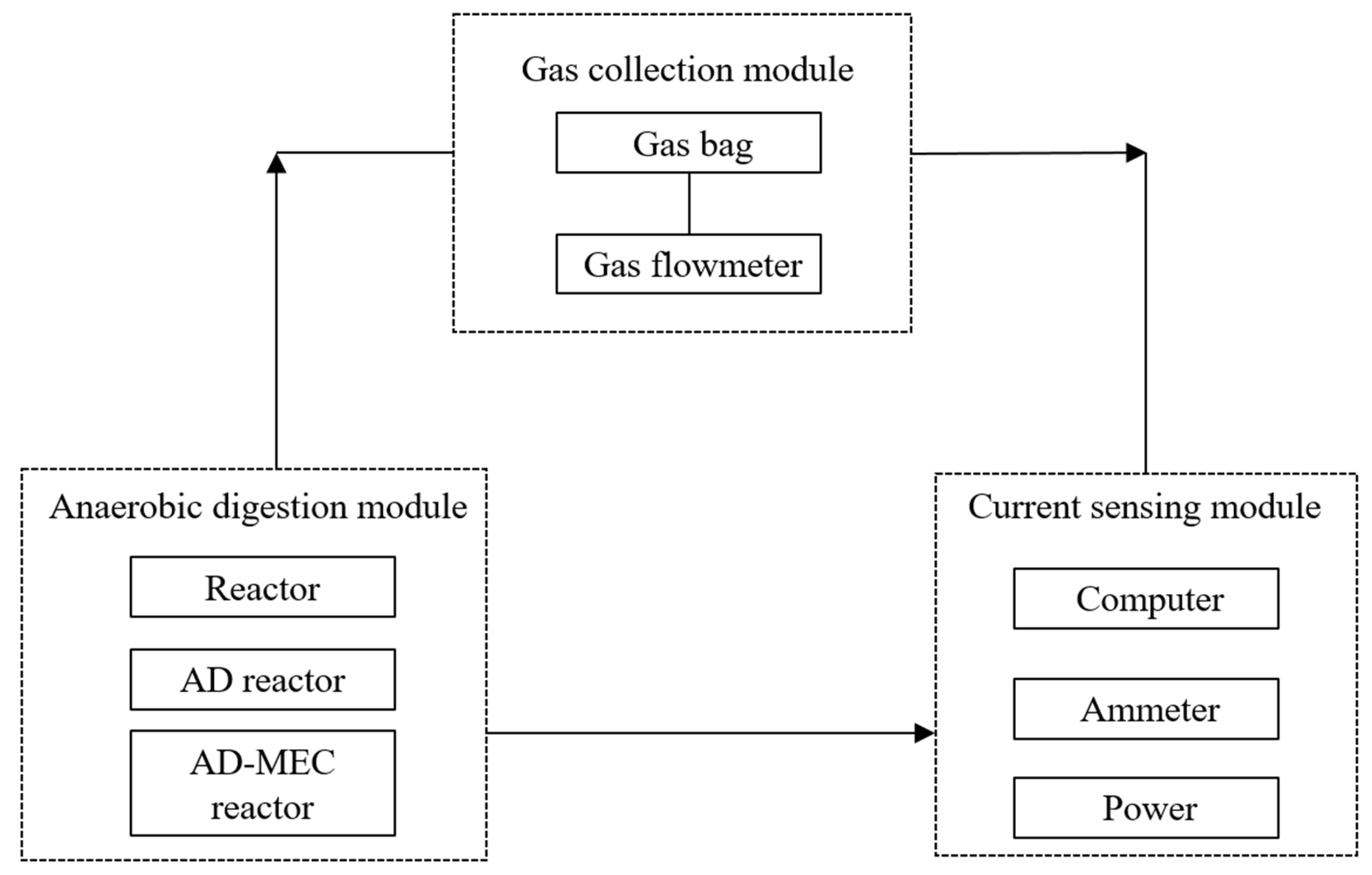
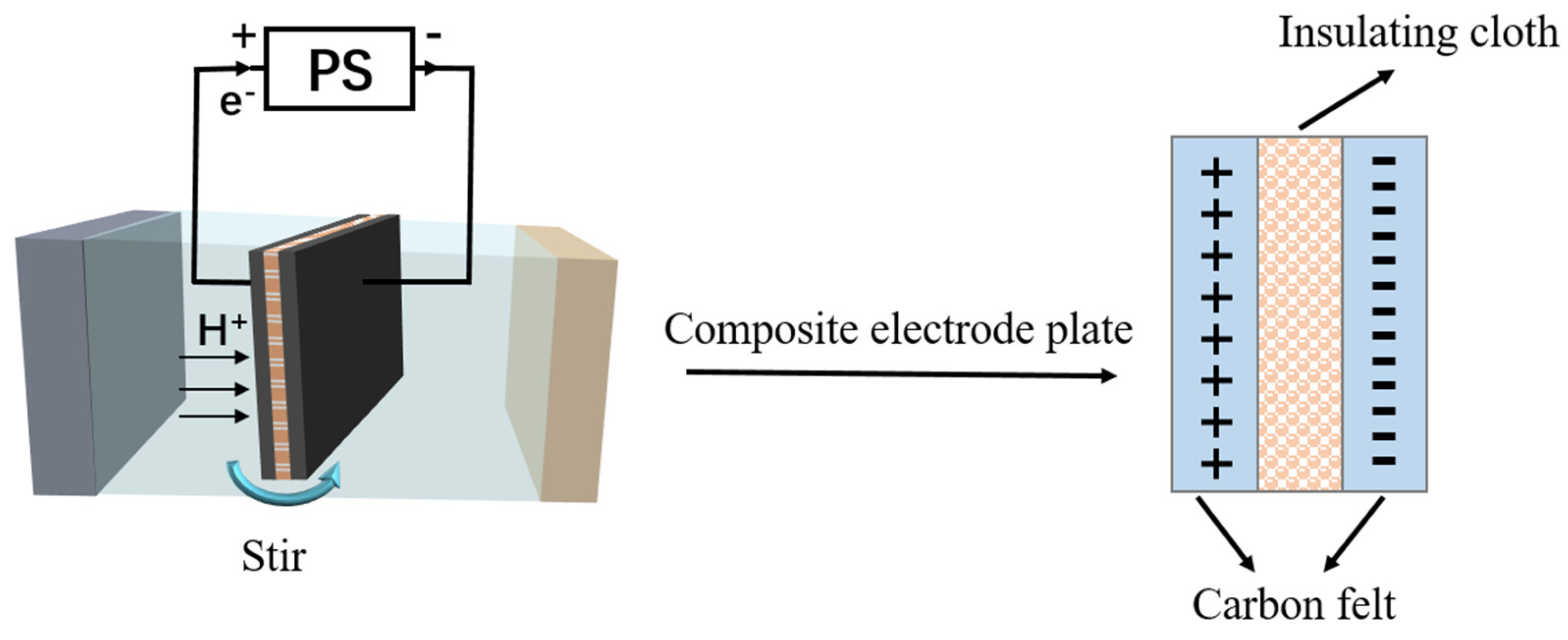
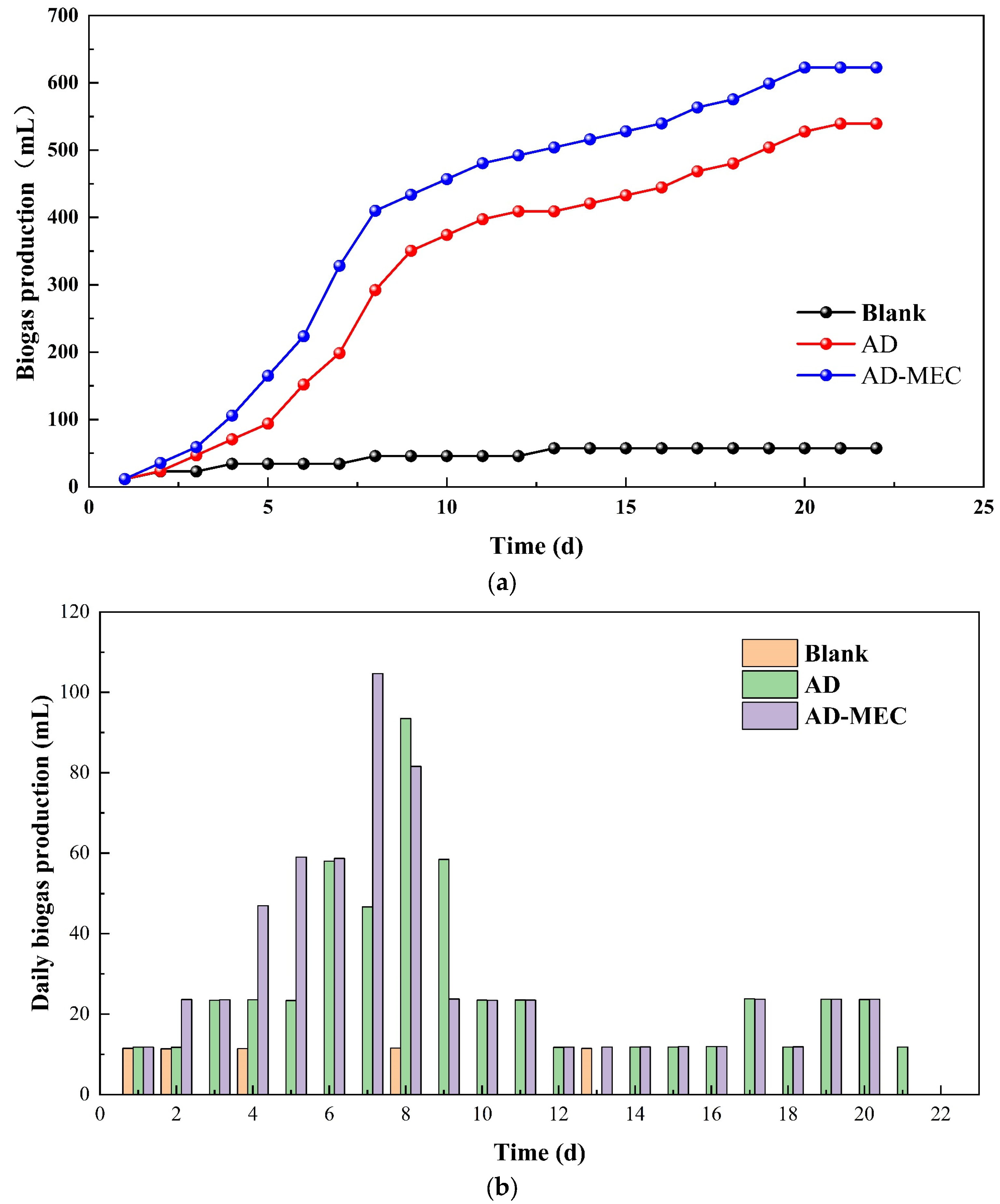
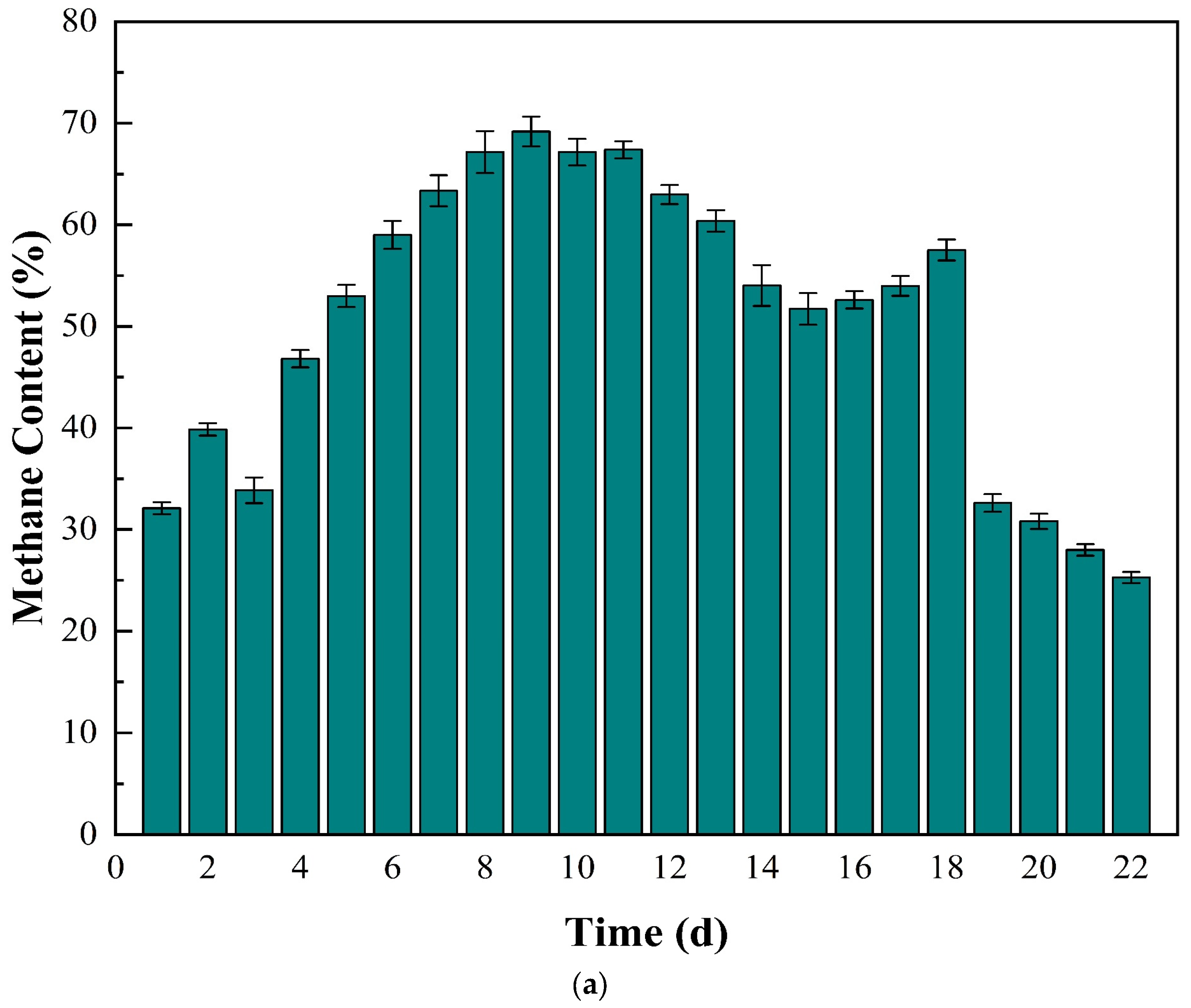
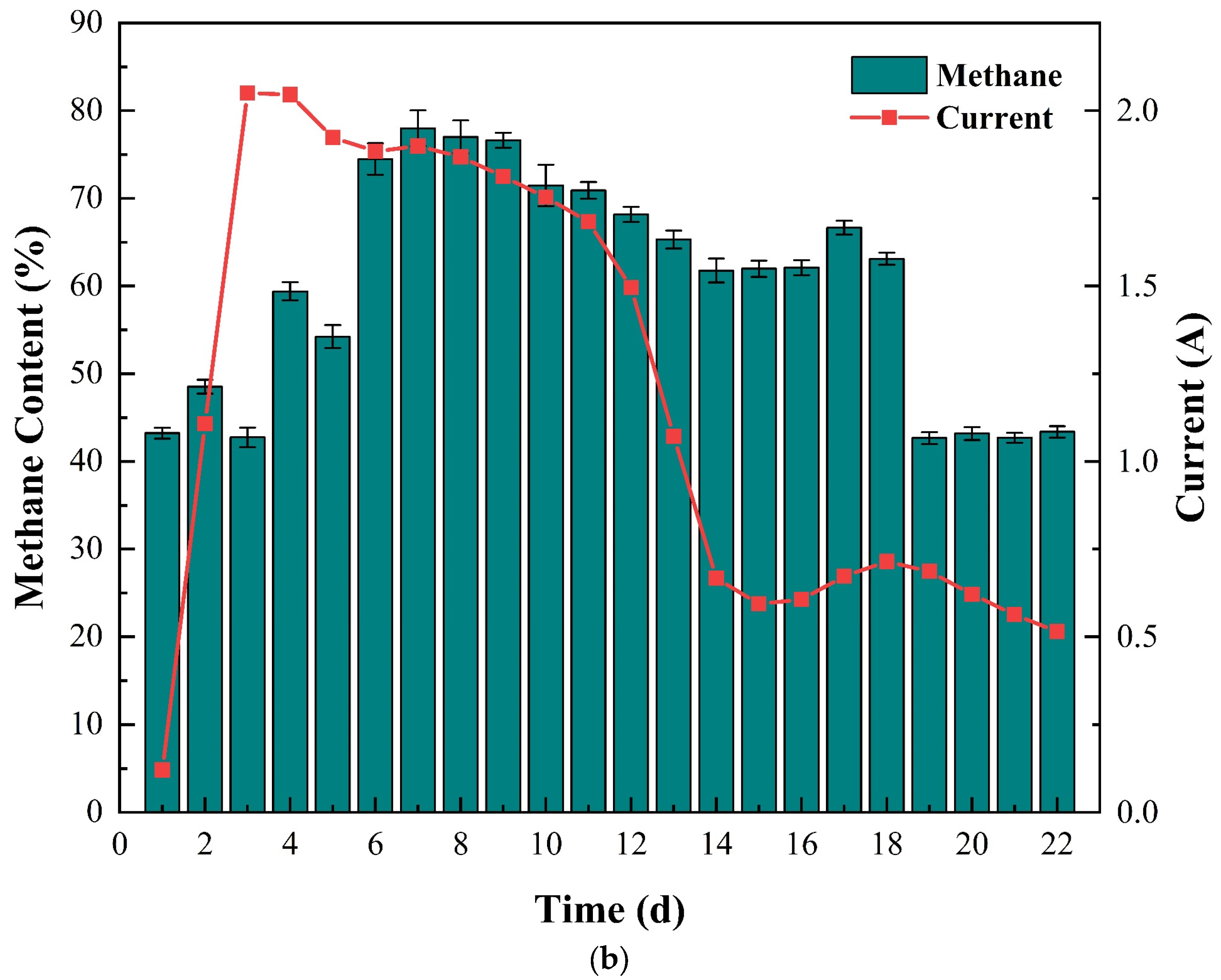
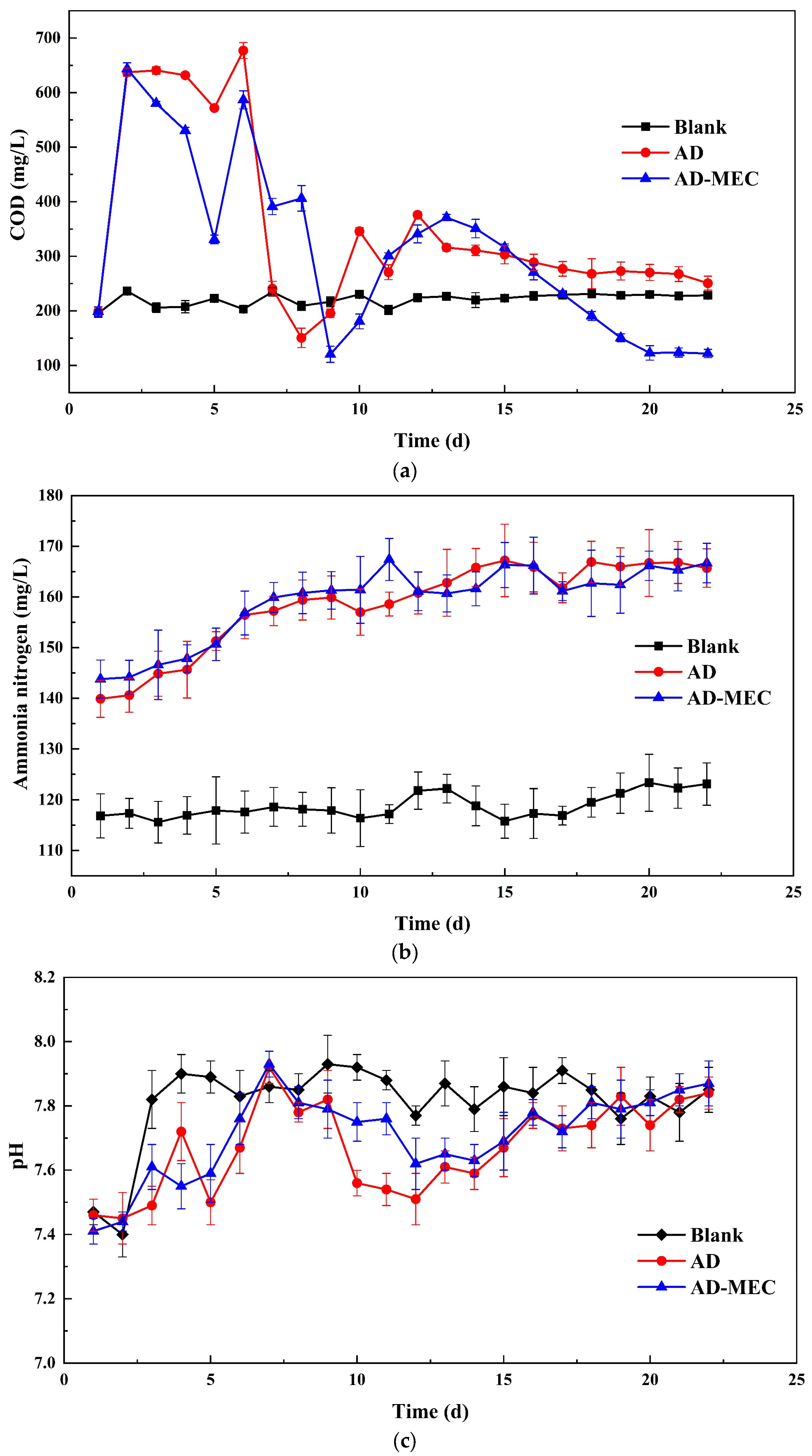
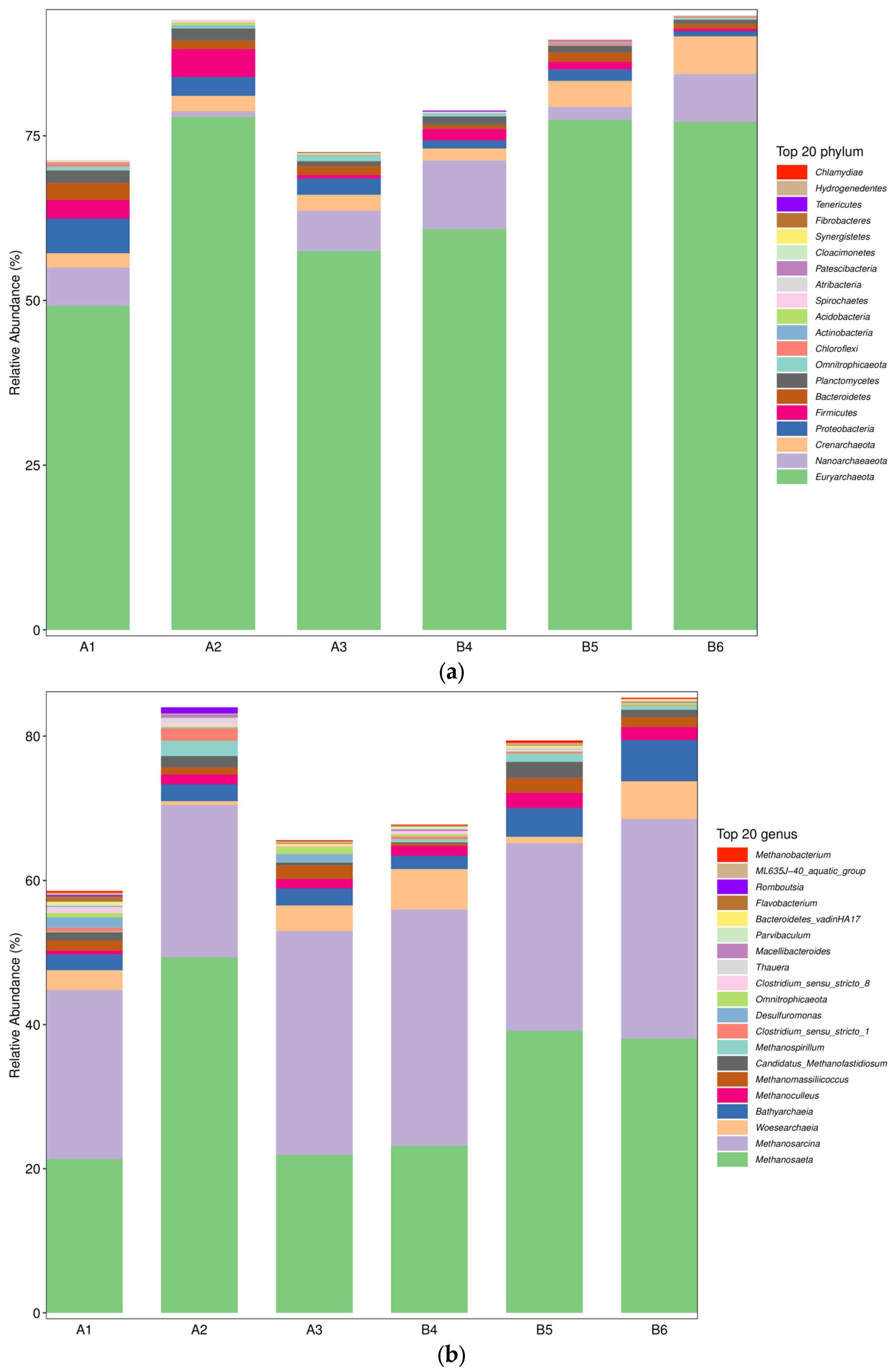
| Sample | Community Richness | Community Diversity | Community Coverage (%) | ||
|---|---|---|---|---|---|
| Chao | Observed Species | Simpson | Shannon | ||
| A1 | 603.052 | 586.6 | 0.945312 | 6.4596 | 0.997748 |
| A2 | 377.621 | 370 | 0.869242 | 4.83712 | 0.999953 |
| A3 | 529.281 | 522.4 | 0.923794 | 5.95533 | 0.998652 |
| B4 | 489.236 | 477.6 | 0.925118 | 6.0569 | 0.998338 |
| B5 | 202.02 | 202 | 0.86594 | 4.80455 | 0.998736 |
| B6 | 375.324 | 368.9 | 0.865377 | 4.70824 | 0.998871 |
Disclaimer/Publisher’s Note: The statements, opinions and data contained in all publications are solely those of the individual author(s) and contributor(s) and not of MDPI and/or the editor(s). MDPI and/or the editor(s) disclaim responsibility for any injury to people or property resulting from any ideas, methods, instructions or products referred to in the content. |
© 2023 by the authors. Licensee MDPI, Basel, Switzerland. This article is an open access article distributed under the terms and conditions of the Creative Commons Attribution (CC BY) license (https://creativecommons.org/licenses/by/4.0/).
Share and Cite
Wu, Q.; Xiao, H.; Zhu, H.; Pan, F.; Lu, F. Carbon Felt Composite Electrode Plates Promote Methanogenesis through Microbial Electrolytic Cells. Energies 2023, 16, 4416. https://doi.org/10.3390/en16114416
Wu Q, Xiao H, Zhu H, Pan F, Lu F. Carbon Felt Composite Electrode Plates Promote Methanogenesis through Microbial Electrolytic Cells. Energies. 2023; 16(11):4416. https://doi.org/10.3390/en16114416
Chicago/Turabian StyleWu, Qi, Han Xiao, Hongguang Zhu, Fanghui Pan, and Fulu Lu. 2023. "Carbon Felt Composite Electrode Plates Promote Methanogenesis through Microbial Electrolytic Cells" Energies 16, no. 11: 4416. https://doi.org/10.3390/en16114416
APA StyleWu, Q., Xiao, H., Zhu, H., Pan, F., & Lu, F. (2023). Carbon Felt Composite Electrode Plates Promote Methanogenesis through Microbial Electrolytic Cells. Energies, 16(11), 4416. https://doi.org/10.3390/en16114416






